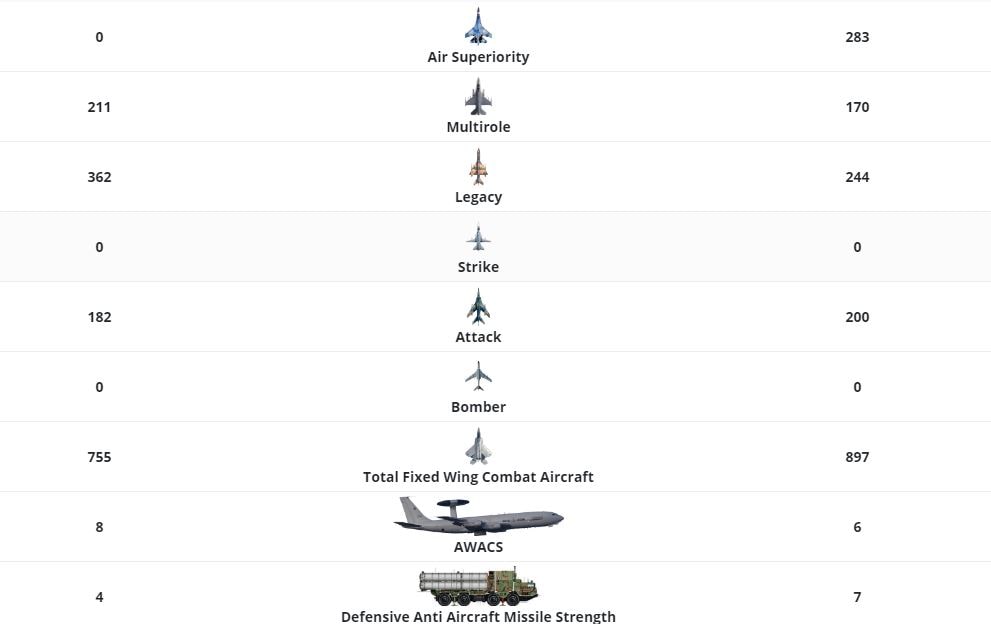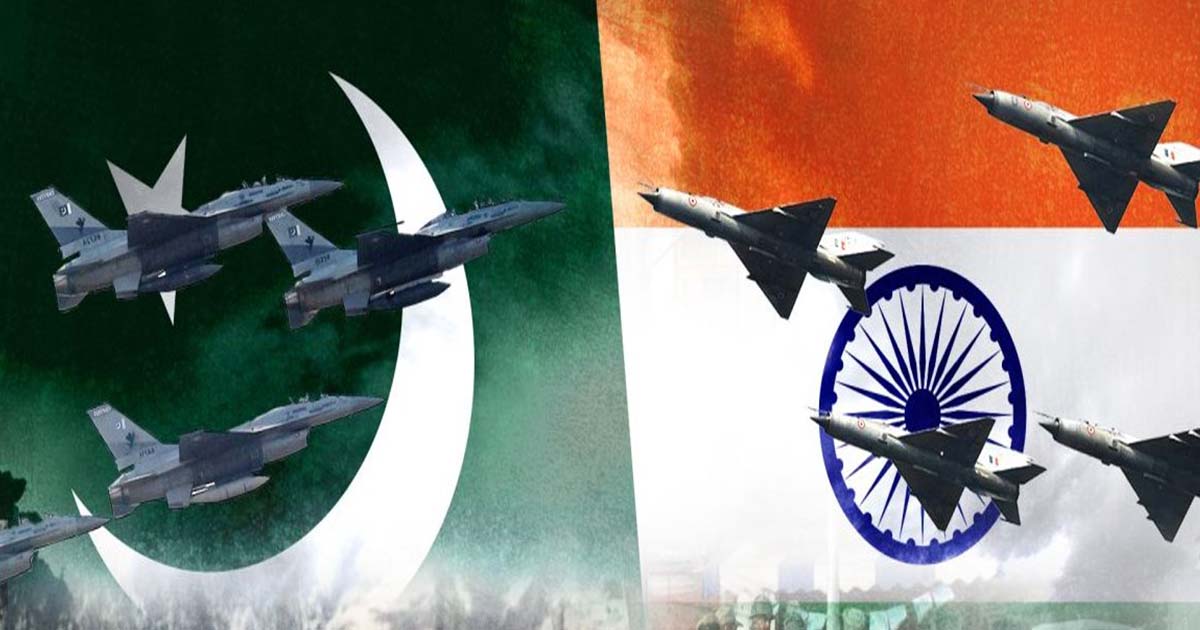Air Force is the leg of the Armed Forces of the country that is responsible primarily for conducting aerial warfare. These aerial warfare are distinct from other two forces i.e. Army & Navy. Typically, air force is responsible for gaining control of country’s airspace and protecting it from any kind of land or aerial penetration.
An air force’s job description also is to provide support to ground and naval forces of country often in the form of aerial reconnaissance and close air support. Air force is often indulged in strategic and tactical bombing missions or tailored surgical strikes behind enemy lines.
In February 2019, Pakistani and Indian air forces crossed paths with latter losing planes and former capturing an Indian pilot. Several claims were made of air superiority as have been for past many years.

But on what basis were these claims made? Man-power? Weaponry? Let’s delve into complete research about the manpower and the range of weapons both the air forces hold. What planes do they fly? What helicopters hover over their air spaces?
All the figures in the article have been taken from “Military Watch”.
Keep in mind that this is just a comparison of the assets both the navies hold, we are not endorsing a conflict OR by any mean making assumptions about war.
Comparison between Air Forces
This comparison is restricted only to the Air forces i.e. Pakistan Air Force & Indian Air Force.
Aerial Manpower of Pakistan
| Forces | Number |
| Active Soldiers (Active Soldiers refers to military members who are currently serving on full-time status in their military capacity) |
70,000 |
| Reservists
(Reservists are not normally kept under arms and their main role is to be available to fight when their military requires additional manpower) |
8,000 |
| Civilian Personnel
(Civilians working in Naval force without a proper commission) |
128 |
Aerial Manpower of India
| Forces | Number |
| Active Personnel | 170,000 |
| Officers | 12,550 |
| 12,404 Serving | |
| 146 Under strength | |
| Air Men | 142,529 |
| 127,172 Serving | |
| 15,357 Under Strength |
Weaponry
Aerial weapons are of a different breed than land and Sea. Here is a complete list of weaponry that both countries possess.
Air Superiority
These are specialized heavy platforms with airframes built for and dedicated to air to air combat. These are high end & costly fighter jets only ever produced by Russia, the United States and China.
| Pakistan | India |
| 0 | 283 |
Indian possesses high end 283 Russian Sukhoi Su-30.
Multi-Role
4th Generation
These fighter jets are non specialized lighter platforms with lower acquisition and operational costs. They are capable of fulfilling air to ground and air to air roles.
Pakistan Air Force
Pakistan owns 211 Multi-Role lighter fighter jets.
| JF-17 Thunder | 135 (75 on order) |
| General Dynamics F-16 Fighting Falcon | 76 |
| JF-17 Block 3 | 0 (On order) |
Indian Air Force
India owns 170 Multi-Role lighter fighter jets.
| Mikoyan MIG-29 | 70 |
| Dassault Mirage 2000 | 50 |
| HAL Tejas | 5 |
| Dassault Rafale | 0 (36 on order) |
Legacy
Legacy fighter jets are older jet fighters preceding the Fourth Generation. Many of these platforms have been extensively modernized and can be formidable in combat.
Read more: Pakistan Army vs Indian Army: Complete list of weapons they possess
Pakistan Air Force
Pakistan owns 362 Legacy fighter jets.
| Chengdu J-7 | 148 |
| Dassault Mirage III | 180 |
| Mikoyan MiG-19 (J-6) | 9 |
| Mikoyan MiG-17 (J-5) | 25 |
Indian Air Force
India owns 244 Legacy fighter jets.
| Mikoyan MIG-21 | 244 |
Air to Ground Role
Strike
Heavy fighters specialized in an air to ground role, while retaining limited air to air combat capabilities. Capable of carrying bombs and missiles which are used to strike targets from high altitudes.
| Pakistan | India |
| 0 | 0 |
Attack
These jets are “Light or Medium” weight fighters designed to operate from low altitudes against enemy ground forces. They are very often well armored, and making heavy use of weapons such as short range anti-tank missiles and rotary cannons. Attack jets rarely possess air to air combat capabilities.
Pakistan Air Force
Pakistan owns 182 Attack fighter jets.
| Dassault Mirage 5 | 182 |
Indian Air Force
India owns 200 Attack fighter jets.
| SEPECAT Jaguar | 200 |
Bombers
These are the largest, heaviest and longest ranged combat aircraft in service. Traditionally bombers were designed to deliver nuclear and conventional payloads too far off enemy targets – often on other continents, modern bombers have often been equipped with long range cruise missiles to reduce vulnerability to enemy air defenses.
Read more: Pakistan Navy vs. Indian Navy: Complete list of Weapons they possess
One of the three traditional pillars of a nuclear delivery forces, in service today only in the United States, China, Russia and North Korea.
| Pakistan | India |
| 0 | 0 |
Fixed Wing Combat Aircraft
A fixed-wing aircraft is heavier than air, propelled by a screw propeller or a high-velocity jet, and supported by the dynamic reaction of the air against its wings.
Pakistan Air Force
Pakistan currently owns 755 Total Fixed Wing Combat Aircraft.
Indian Air Force
Indian Air Force currently owns 897 Total Fixed Wing Combat Aircraft
Carrier Based
4th gen. Carrier Based Multirole
The Fourth Generation Fighter is the modern standard in combat warplanes. The term is used for those aircraft designs bridging the gap between the developments of the 1960s and 1970s and those appearing today under the Fifth Generation Fighter classification.
Pakistan Air Force
Pakistan currently does not own any 4th Generation Carrier Based Multirole.
Indian Air Force
India possesses 45 4th gen. Carrier based multirole jets.
| Mikoyan MiG-29K | 45 |
AWACS
Airborne radar picket systems able to detect hostile targets at extreme ranges. Highly effective as a force multiplier in aerial engagements able to perform command and control of aerial assets and directing strikes by combat aircraft.
Pakistan Air Force
| Pakistan | 8 |
Indian Air Force
| India | 6 |
Anti-Aircraft Missile System
Countries are rated from 1-10 on their capability in anti-aircraft missile system capability. Rating takes into account training of anti-aircraft crews, SAM systems available and their proven effectiveness in testing and combat, modernizations and modifications made to older systems, fortifications used to protect SAM systems and the range and concentration of anti-aircraft capable SAMs relative to the size of the territory being defended.
Read more: 1947- 2019: A List of Army Chiefs who lead Pakistan’s Army
They are further divided into 3 ranges.
Pakistan Air Force
Pakistan scored 4 out of 10 in its anti-aircraft missile system capability.
Long Range
- HQ-9
Medium Range
- BUK
- S-75
Short Range
- Thales Crotale
Indian Air Force
India scored 7 out of 10 in its anti-aircraft missile system capability.
Long Range
- S-400
- S-300
Medium Range
- S-125
- Akash
Short Range
- 2K22 Tunguska
- 9K31 Strela-1
- 9K35 Strela-10
- SPYDER
- Tor
- 9K33 OSA














